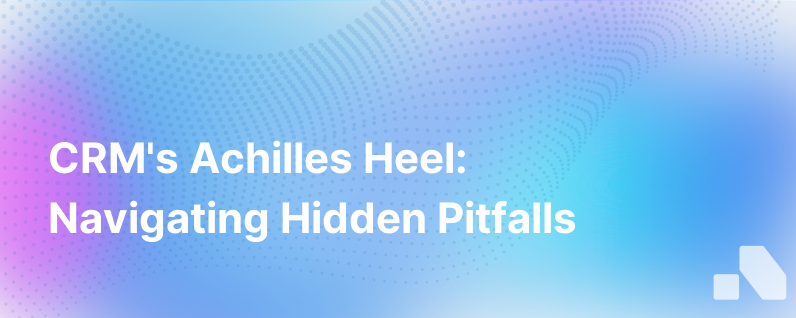Crms Achilles Heel
Published on December 6, 2023 by Sawyer Middeleer
Customer Relationship Management (CRM) systems are the backbone of many B2B sales organizations. They’re powerful tools designed to centralize customer information, manage sales processes, and drive revenue growth. But even the mightiest backbones can have a weakness, an Achilles' heel, that can impede their overall effectiveness. When discussing CRM systems, this vulnerability often manifests in the form of data quality issues, user adoption struggles, and an inability to provide actionable insights.
The Achilles' heel of CRM platforms is more than just a single flaw—it's a combination of pain points that, if unaddressed, can cripple a sales organization's ability to execute effectively. This article will dissect these underlying issues with CRM systems and offer guidance on how to overcome them.
The Achilles Heel of CRM: Data Integrity
Perhaps the most significant weakness of CRM platforms revolves around data integrity. Without accurate, up-to-date, and complete data, a CRM system's effectiveness is seriously compromised. Studies suggest that sales reps spend up to 27% of their time searching for or entering data. This time could be better spent selling and fostering relationships but is instead squandered due to poor data hygiene.
Data Silos and Duplication
Data silos often result from fragmented processes and inadequate system integration. Information captured by marketing, sales, and customer support operates in isolation, creating data inconsistencies and inefficiencies. Duplication arises when these silos overlap, cluttering the CRM with multiple entries for the same customer, leading to confusion and diluting trusted data sources.
Outdated Information
The pace of business renders data obsolete quickly. From changing job titles to companies merging or closing, the failure to maintain current records in the CRM reflects poorly on sales reps' preparation and negatively impacts outreach efforts.
Manual Entry and Human Error
Relying on manual entry is a gateway to human error. Mistyped emails, incorrect phone numbers, or mislabeled lead statuses can skew the data, rendering many of CRM's analytical tools useless.
User Adoption and Engagement
A tool is only as good as its user's ability to wield it. Low user adoption rates are the manifestation of the CRM’s second Achilles' heel. The reasons behind low adoption rates vary, but they often stem from systems being viewed as too complex, burdensome, or not user-friendly.
Resistance to Change and Lack of Training
Sales reps are creatures of habit, and adopting a new CRM system often faces the inertia of the status quo. Without adequate training and incentives to utilize the system, sales reps can revert to their old ways, thus preventing the CRM from delivering its full value.
Perceived as a Monitoring Tool
CRMs must not be perceived solely as a tool for managerial oversight. A CRM that's seen as a "Big Brother" can foster an environment where sales reps only input the minimum required information, thus defeating the system’s purpose.
Limited Actionable Insights
The final Achilles' heel is often the CRM's inability to turn the vast amounts of data collected into actionable insights. Despite the promise of data-driven decision-making, many CRMs fall short in this regard.
Lack of Customizable Reporting
A one-size-fits-all approach doesn't work with reporting. Each business has unique metrics that drive their goals. If a CRM lacks customizable reporting features, it fails to provide the insights necessary for informed decision-making.
Overwhelming Amount of Data
While having vast amounts of data is often considered an asset, without the tools to properly analyze and leverage this data, it becomes a burden. Navigation through the data swamp can be time-consuming and often futile if the CRM cannot distill it into actionable intelligence.
Real-Time Data Analysis
In a fast-paced sales environment, lag in data analysis can mean missed opportunities. CRMs that don't offer real-time analytics can't provide the immediate insights needed to adapt sales strategies dynamically.
Overcoming The Achilles' Heel
Defeating these weaknesses requires a blend of technology solutions and strategic processes.
Enhancing Data Integrity
This means investing in data cleaning services, integrating systems to reduce silos, and automating as much of the data entry process as possible.
Improving User Adoption
By simplifying the interface, customizing the CRM to fit the needs of the sales team, investing in comprehensive training, and demonstrating the tool's value through improved sales results, you can enhance user engagement and adoption.
Cultivating Actionable Insights
Deploy advanced analytics and AI to sift through the data and provide real-time, actionable insights. Customizable dashboards that focus on key performance indicators can assist decision-makers to quickly understand and act on the information presented.
Conclusion
The strengths of CRM systems are undeniable – streamlined operations, a detailed view of the sales funnel, and centralized customer data. However, their weaknesses often lie in data quality, user adoption, and actionable insights.
A CRM's data can only be deemed powerful if it’s accurate, current, and clean. User adoption hinges on the system’s ease of use and perceived value to the sales rep on the ground. Finally, a CRM must be able to transform raw data into actionable strategies readily applicable to the sales process.
Addressing the Achilles' heel of CRM systems requires a thoughtful combination of technical solutions and a commitment to operational excellence. It involves leveraging tools offered by platforms like Aomni that provide real-time account research, competitive insights, and sales content that's personalized and actionable.
When these issues are overcome, the full potential of the CRM can be unleashed, resulting in a high-performing sales organization primed for strategic growth.